Heartbeat with heart rate graph illustration Stroke and heart attack are both serious medical conditions that occur when the blood supply to a part of the body is interrupted or reduced. The difference between heart attack and stroke lies in their specific effects and the organs they impact.
A stroke happens when the blood supply to a part of the brain is cut off, causing brain cells to die. This can result in lasting brain damage, long-term disability, or even death. On the other hand, a heart attack occurs when the blood flow to a part of the heart is blocked, often by a blood clot. In essence, a stroke affects the brain, while a heart attack affects the heart muscle.
This can damage or destroy part of the heart muscle, leading to serious health complications or fatality. Both conditions require immediate medical attention.
The Causes: What Triggers Stroke and Heart Attack?
Both stroke and heart attack are primarily caused by disruptions in the circulatory system.
A stroke is generally triggered by one of two conditions: ischemic, where blood flow is blocked due to clots or fatty deposits; or hemorrhagic, where a blood vessel in the brain bursts or leaks.
Heart attacks, on the other hand, are usually caused by coronary artery disease. This condition results from a buildup of plaque in the arteries, which can rupture and form a clot, blocking blood flow to the heart muscle. Other factors such as high blood pressure, smoking, obesity, diabetes, and excessive alcohol consumption can increase the risk for both conditions.
Identifying the Symptoms: How Does a Stroke Differ from a Heart Attack?
While there are similarities between the symptoms of a stroke and heart attack, there are crucial differences.
Stroke symptoms often appear suddenly and include numbness or weakness in the face, arm, or leg, especially on one side of the body, confusion, trouble speaking or understanding speech, blurred or blackened vision, and severe headache. Heart attack symptoms, on the other hand, may start slowly and intensify over time.
They typically include discomfort in the chest, shortness of breath, and pain in the upper body, such as arms, back, neck, jaw, or stomach. Both conditions may cause dizziness and loss of coordination. Immediate medical attention is critical in both cases.
Medical Interventions: Treatment Options for Stroke and Heart Attack
When it comes to medical interventions for stroke and heart attack, time is of the essence. Early treatment can minimize damage and improve outcomes.
For strokes, treatment depends on the type. Ischemic strokes, caused by clots, are often treated with medications to break up or prevent clot formation. In some cases, a procedure called thrombectomy is performed to directly remove the clot from the brain. Hemorrhagic strokes, caused by bleeding, may require surgery to repair blood vessel abnormalities.
Heart attacks, typically caused by blocked coronary arteries, are treated using medications to dissolve clots, reduce heart strain, and prevent future clots. Percutaneous coronary intervention (PCI), commonly known as angioplasty, can be used to open blocked arteries. In severe cases, bypass surgery might be needed to redirect blood flow around the blockage.
Post-treatment, rehabilitation, and lifestyle modifications like healthy diet, regular exercise, quitting smoking and managing stress play vital roles in recovery and preventing recurrence. Always consult healthcare professionals to understand the best treatment options.
Prevention Strategies: Reducing the Risk of Stroke and Heart Attack
Prevention is a crucial component in combating both stroke and heart attack. Lifestyle changes can significantly reduce the risk.
Healthy Diet: Consuming a diet rich in fruits, vegetables, whole grains, lean proteins, and low-fat dairy can help maintain healthy blood pressure and cholesterol levels, reducing the risk of clots and artery blockage.Physical Activity: Regular exercise helps improve cardiovascular health, manage weight, and control diabetes - all factors that contribute to stroke and heart attack risk.
Tobacco and Alcohol: Avoiding tobacco and limiting alcohol consumption can significantly lower risk. Smoking damages blood vessels, making clots more likely, while excessive alcohol can raise blood pressure.
Regular Check-ups: Regular medical check-ups help monitor blood pressure, cholesterol, and glucose levels, enabling early detection and management of potential issues.
Stress Management: Chronic stress can contribute to high blood pressure and other cardiovascular risks. Techniques such as meditation, yoga, or simple relaxation exercises can help manage stress levels effectively.
Remember, it's never too late to make positive lifestyle changes. Consult your healthcare provider for personalized advice.
Life After the Event: Recovering from a Stroke or a Heart Attack
Recovering from a stroke or heart attack is a journey that requires patience, determination, and a positive mindset.
Stroke recovery often involves physical, occupational, and speech therapies to regain lost abilities. This can include relearning how to walk, improving hand-eye coordination, or regaining speech and swallowing capabilities. It's important to remember that progress may be slow and varies from person to person, but every step forward counts.
After a heart attack, cardiac rehabilitation is typically recommended. This involves education on heart-healthy living, stress management, and physical activity guidance. Medication is often prescribed to manage symptoms and prevent future attacks.
In both cases, emotional support is crucial. Depression and anxiety are common, and psychological therapy or support groups can provide immense help. Lastly, lifestyle modifications like a balanced diet, regular exercise, smoking cessation, and controlled alcohol use are pivotal for a healthy life post-recovery.
Remember, it's not just about surviving, but thriving after the event. Consult your healthcare provider for a tailored recovery plan.


